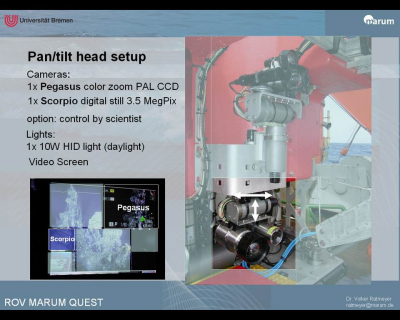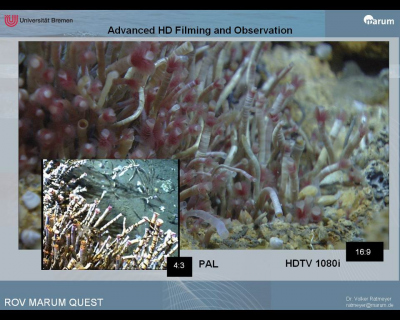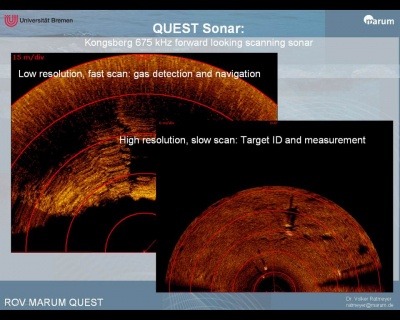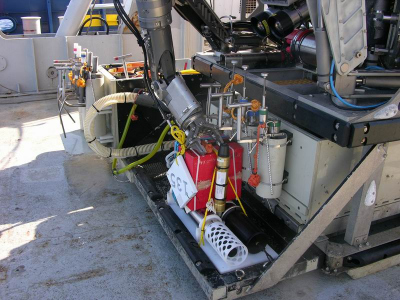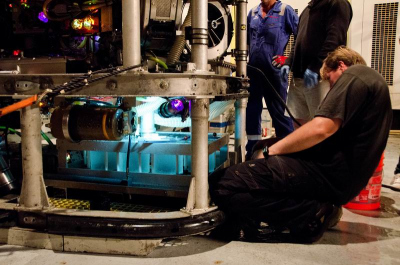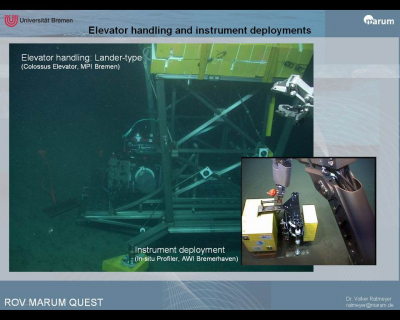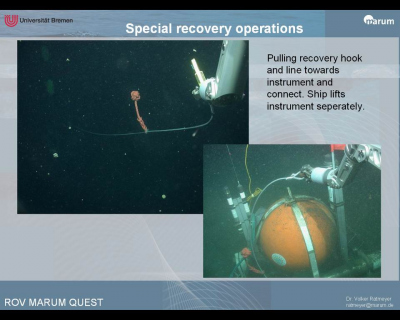Die Inhalte dieser Seite sind leider nicht auf Deutsch verfügbar.
Seitenpfad:
User Guide
The following slides provide some insight into the scientific capabilities of QUEST, including the kind of access that scientists will have to samples and data during a cruise.
Please note that this information is not complete due to the changing tasks and payloads between expeditions. For detailed planning, please contact us directly.
Please note that this information is not complete due to the changing tasks and payloads between expeditions. For detailed planning, please contact us directly.
Imaging
Video recording and photography
Video Recording is conducted digitally during the entire dive. By default, recording is started at first visual bottom contact, and terminated at leaving seafloor, unless otherwise defined. 2 PAL cameras, 1 HDTV zoom camera, and 1 combined pilot screen with all 7 visible feeds are recorded via H.264 compression onto digital harddisk. In addition, continuous framegrabs will be recorded of all recorded feeds in 10 second intervals. The combined pilot video screen can be distributet via ships network, if network provides sufficient bandwidth.
Digital still photographs are taken upon request by either the pilots or a trained scientist. Image resolution is 3.5 MPix. Images are available after each dive. In addition, a 10 MPix downward looking digital still camera can be used for photo mosaicking or vertical image sequences of the seafloor.
Digital still photographs are taken upon request by either the pilots or a trained scientist. Image resolution is 3.5 MPix. Images are available after each dive. In addition, a 10 MPix downward looking digital still camera can be used for photo mosaicking or vertical image sequences of the seafloor.
HDTV imaging
The onboard 3-chip HDTV color zoom camera provides an extremely detailed view. The corrected lens stack includes a powerful 14x zoom, enabling both detailed overviews during flight, as well as exceptional closups when zoomed in. By default, the camera is mounted on the starboard toolskid drawer.
Display of the HD-feed can be seen on the HD monitors in the van and lab.For highest quality, HD can be recorded on request on professional HD tapes (SONY HDCam format). Scientists are responsible for tape changes.
Display of the HD-feed can be seen on the HD monitors in the van and lab.For highest quality, HD can be recorded on request on professional HD tapes (SONY HDCam format). Scientists are responsible for tape changes.
Sonar imaging
A forward loocking, 675 kHz Kongsberg scanning sonar provides continuous information in variable ranges up to 100 m horizontal distance. Applications are navigation, morphology mapping (i.e. chimneys), device detection and gas flare detection. The sonar screen is displayed inside the control van and operated by the pilots.
A Benthos SIS 1600 series sidescan sonar is mounted onto the toolskid as standard. It can be used for a number of mapping tasks. During a dive, the sidescan will have to be supervised and operated by the science party, from a client station in the lab. A mirrored screen is available inside the control van.
A Benthos SIS 1600 series sidescan sonar is mounted onto the toolskid as standard. It can be used for a number of mapping tasks. During a dive, the sidescan will have to be supervised and operated by the science party, from a client station in the lab. A mirrored screen is available inside the control van.
Sampling
Sampling tools and payloads
A variety of sampling tasks can be performed using our two hydraulic manipulators. Depending on the scientific goal, QUEST is to be prepared with a suite of modular sample devices. The Marum standard suite includes sample boxes, a suction sampler, various hand tools, pushcores and a fluid sampling system. Also available are pressure preserving sample containers, gas samplers and other dedicated scientific equipment.
QUEST can be prepared for special sampling tasks between 2 dives utilizing a modular container system, allowing a fast exchange on the two front drawers and the central aft toolskid bay. Experiments and special containers can be prepared prior to a dive while the system is still submerged, and easily exchanged after recovery. However, tests and preparation need time to ensure correct operation.
QUEST can be prepared for special sampling tasks between 2 dives utilizing a modular container system, allowing a fast exchange on the two front drawers and the central aft toolskid bay. Experiments and special containers can be prepared prior to a dive while the system is still submerged, and easily exchanged after recovery. However, tests and preparation need time to ensure correct operation.
Images: Sean Diaz, sdpropho
Intervention and sensor deployment
Lift operations
In cooperation with the MPI for Marine Microbiology, Bremen, operations for instrument and sensor deployments were developed by utilizing two different freefall elevator systems, designed by MPI Bremen. Instruments can be detached from the lift with QUEST and placed precisely at their seafloor destination. This setup is routinely used for different types of heavy autonomous instruments and small observatories.
Recovery operations
After special request and preparation, instrument or heavy device recoveries can be carried out using a 2nd wire deployed by the research vessel. However, such operations are not standard, and require explicit planning and confirmation, also in close cooperation with the vessel's crew. Prior to a cruise, any recovery operations have to be explicitely applied for by the science party.
QUEST data products
During the cruise, data and imagery will be provided to the chief scientist at different levels of processing. The following table gives an overview of a standard data product aquired during a QUEST cruise. Please note, that all underwater images and videos obtained with QUEST are subject to a copyright agreement.
| Product | Output time | Medium |
| QUEST database readout (USBL positions, depth and altitude data, DVL velocity data, headings, still image names, ctd data, others...) | after each dive | CD or via network |
| Video recordings | 3-4 times during cruise | harddisk |
| Video framegrabs | after each dive | CD or via network |
| Still photographs | after each dive | CD or via network |
| Video compilation ("Best Of") | end of cruise | DVD or harddisk |
Scientific interface specification
For interfacing any scientific equipment such as sensors, sample tools, cameras or any other device to be mounted on, or handled with QUEST, a "Peripheral device specification form" has to be filled out and delivered to the QUEST team at least 8 weeks prior to the begin of the proposed expedition. The form provides all necessary questions to decide if devices can be handled or interfaced with QUEST, and helps to identify what kind of adaptation work might be necessary. A delivery of the form in time is critical and will be handled strictly.
Copyright agreement for underwater imagery and video
Images and videos taken with the ROV QUEST during a seagoing expedition underlie a general copyright agreement:
Digital underwater images, videos, and data produced and distributed during a particular cruise are explicitely dedicated for use in scientific, non-commercial applications. The copyright of all underwater image and video material is held by the MARUM - Center for Marine Environmental Sciences, University of Bremen, Germany. In case of scientific publication and print on paper or in any electronic form the reference "copyright: MARUM, University of Bremen" has to be cited for each image or feed. In addition a written notification with publication reference and - if possible - a paper copy has to be send to below MARUM adress.
Any further publication in non-scientifc media, such as journals, newspapers, books, advertisings, catalogues, flyers, television or others, requires the explicit confirmation of MARUM prior to publication.
Please send requests and notifications of publications to one of the following adresses:
Digital underwater images, videos, and data produced and distributed during a particular cruise are explicitely dedicated for use in scientific, non-commercial applications. The copyright of all underwater image and video material is held by the MARUM - Center for Marine Environmental Sciences, University of Bremen, Germany. In case of scientific publication and print on paper or in any electronic form the reference "copyright: MARUM, University of Bremen" has to be cited for each image or feed. In addition a written notification with publication reference and - if possible - a paper copy has to be send to below MARUM adress.
Any further publication in non-scientifc media, such as journals, newspapers, books, advertisings, catalogues, flyers, television or others, requires the explicit confirmation of MARUM prior to publication.
Please send requests and notifications of publications to one of the following adresses:
| MARUM Zentrum für Marine Umweltwissenschaften Dr. Volker Ratmeyer Universität Bremen Leobener Straße 28359 Bremen Germany Tel +49 421 218 65604 Fax +49 421 218 98 65604 email [Bitte aktivieren Sie Javascript] | MARUM Zentrum für Marine Umweltwissenschaften Öffentlichkeitsarbeit Nils Strackbein Universität Bremen Leobener Straße 28359 Bremen Germany Tel +49 421 218 65540 Fax +49 421 218 98 65540 email [Bitte aktivieren Sie Javascript] |
Contact
For further informations or special requests please contact us:
| Name | Phone | field | |
| Volker Ratmeyer | +49 421 218 65604 | [Bitte aktivieren Sie Javascript] | mssion and system planning |
| Christian Reuter | +49 421 218 65624 | [Bitte aktivieren Sie Javascript] | vehicle and payloads |
| Marcel Zarrouk | +49 421 218 65617 | [Bitte aktivieren Sie Javascript] | imaging and video |



